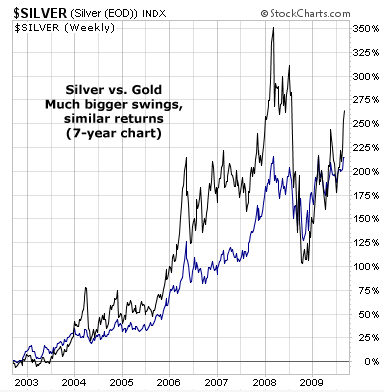| Home | About Us | Resources | Archive | Free Reports | Market Window |
Where All the Money You'll Ever Make in Stocks Will Come FromBy
Saturday, September 12, 2009
I'm convinced the return of the king is upon us.
It's often said that cash is king. But for the past generation or so, nobody cared much for the guy. Consumers borrowed as much of him as they could to buy stuff they couldn't afford. Investors avoided him because they wanted to speculate on Internet stocks, condos, and commodities. But now, more than at any time in the past three decades, investors need to own stocks that consistently pay cash dividends. It's too risky to own the traditional junk most folks typically own. Everyone seems to have forgotten about them today, but dividends are the main way you make money in stocks over the long term. If you're going to get rich in stocks, you're going to receive lots of dividends, and you're going to reinvest those dividends. Growing rich in stocks over time has meant this for much of the last two centuries. Referring to a study of the period from 1872 to 2000 in his excellent book, Behavioural Investing, analyst James Montier says, "Over the long term, dividend yield has provided over 50% of the total return to equities!" Montier's findings also showed that, during the turbulent 1970s, growth and valuation changes produced negative results, but stockholders still made money by collecting cash dividends. When times got tough, dividends were all you earned from stocks. From 1970 through 1982, the U.S. went through four recessions. Inflation averaged 5% per year. Other similar studies I've seen suggest Montier's data overstates the case slightly, but the point remains: Dividends bailed investors out during the 1970s. But that's just the payment of cash dividends. It says nothing of the power of reinvested dividends. In The Future for Investors, Wharton professor Jeremy Siegel published an even more astounding finding: From 1871 to 2003, 97 percent of the total after-inflation accumulation from stocks comes from reinvesting dividends. Only 3 percent comes from capital gains.Whether it's a 132-year epoch or a turbulent decade during which inflation has investors too scared to buy, the data all point in one unmistakable direction. As financial researcher and investment manager Rob Arnott put it, "Dividends not only dwarf inflation, growth, and changing valuation levels individually, but they also dwarf the combined importance of inflation, growth, and changing valuation levels." Dividends rule. Over your lifetime, the odds are squarely against any outcome but this: You'll either make a lot of money on reinvested dividends or you won't make much money in stocks. How can you get started earning dividends and then reinvesting them? Or stated more simply, how can you start getting rich in stocks? I don't think you can do better than what I've been telling my Extreme Value readers for years: Stick with the world's best businesses with long uninterrupted histories of increasing their dividends. Stick with what I call "World Dominators." A World Dominator is generally the largest, most powerful company in its industry. It can raise prices to stay ahead of inflation and use its enormous size to keep costs low. Raising prices or being the lowest-cost provider means these World Dominators tend to crush the competition. So they often generate enormous amounts of cash. That cash can support dividends through good times and bad. Take one of my favorite Dominators, Procter & Gamble. It has raised its dividend every year for 55 years in a row. Or another, Wal-Mart. It has raised its dividend every year of its existence as a public company. As a giant, World Dominating business like P&G or Wal-Mart matures, its excellent competitive position keeps the cash rolling in while the capital expenditures fall due to slower growth. That cash and share repurchases provide investors with growing dividends and capital appreciation. They sport smallish current dividend yields (usually in the 2%-4% area), but as cash flow increases, a Dominator you buy now will yield 10% in five to seven years. By the way, Warren Buffett – the world's richest investor – owns both of these stocks... and a bunch of other World Dominators. He gets it. He knows cash is king. And he sticks with companies that generate mountains of it. I recommend you do the same. Good investing, Dan Ferris P.S. What most investors don't know about World Dominating businesses is that they are among the world's best inflation hedges. They use their dominant brand name positions to increase prices as needed. Their share prices rise as a result. You can learn more about these big inflation hedges – and another incredible one I call "Gold Backed Annuities" – with a trial subscription to Extreme Value. Click here for details.
Further Reading:
Now Is a Once-in-a-Lifetime Opportunity for Income Investors Market NotesSILVER VS. GOLD... THE PAST SEVEN YEARS
|
In The Daily Crux
Recent Articles
|


